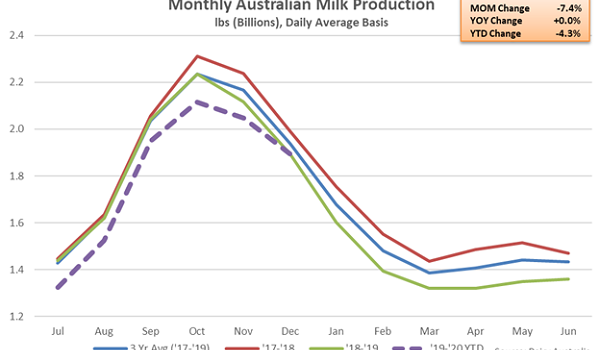
Quarterly Australian Milk Production Update – Feb ’20
Executive Summary
Australian milk production figures provided by Dairy Australia were recently updated with values spanning through the end of the first half of the ’19-’20 production season. Highlights from the updated report include:
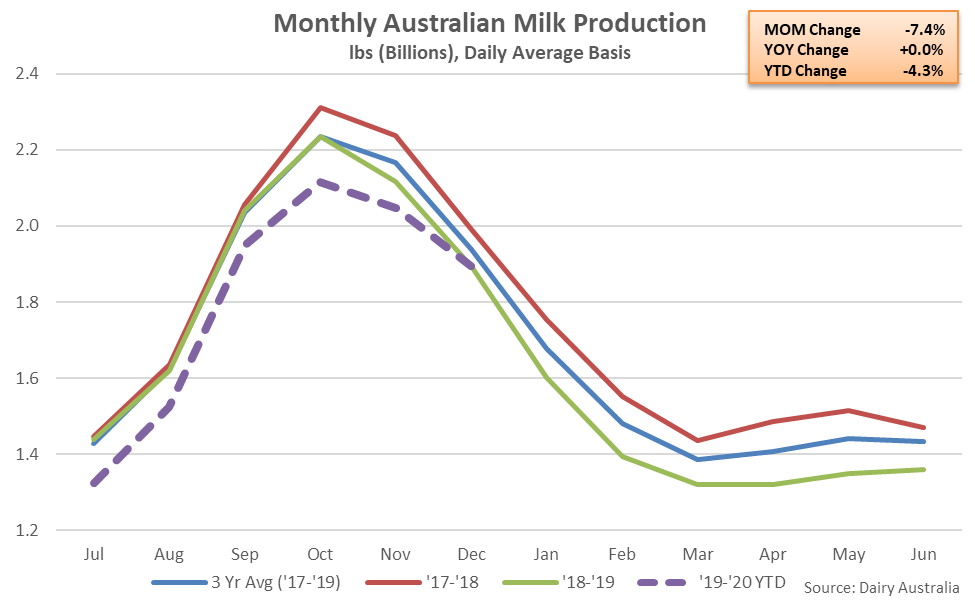 ’17-’18 annual Australian milk production increased 3.0% from the 20 year low experienced throughout the previous production season as improved rainfall led to better pasture growth however ’18-’19 annual production declined 5.7% as dry weather conditions returned, reaching a 24 year low level, overall. USDA is projecting an additional 2.3% YOY decline in Australian milk production throughout the 2020 calendar year.
’17-’18 annual Australian milk production increased 3.0% from the 20 year low experienced throughout the previous production season as improved rainfall led to better pasture growth however ’18-’19 annual production declined 5.7% as dry weather conditions returned, reaching a 24 year low level, overall. USDA is projecting an additional 2.3% YOY decline in Australian milk production throughout the 2020 calendar year.
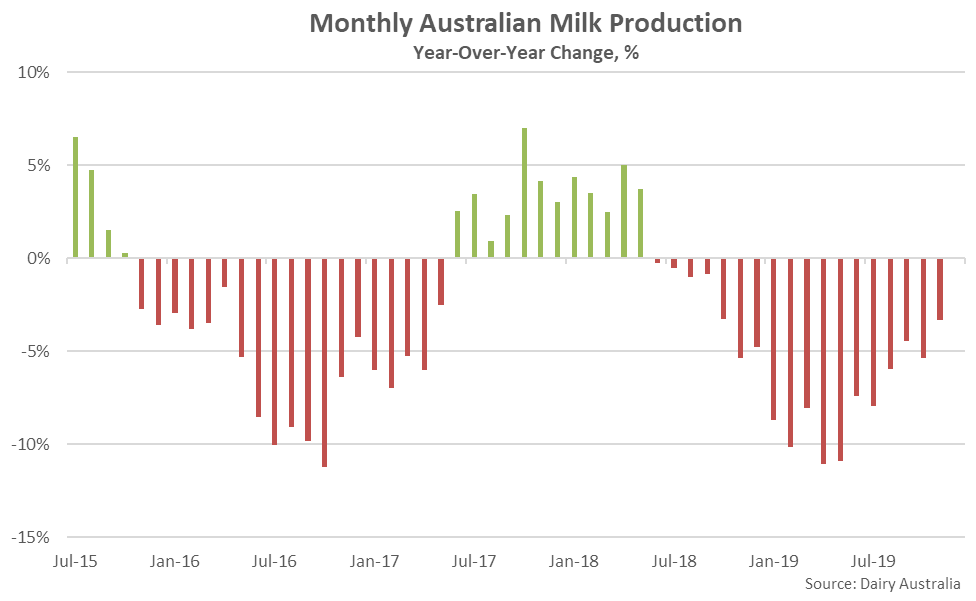 Recently experienced low pasture volumes and supplementary feed on hand contributed to the Australian dairy cow herd contracting by 3.3% throughout 2019, finishing at the lowest figure on record. USDA expects the Australian dairy cow herd will decline by an additional 1.7% throughout 2020, despite projected improvements in pasture conditions, due to biological lags in herd rebuilding.
Recently experienced low pasture volumes and supplementary feed on hand contributed to the Australian dairy cow herd contracting by 3.3% throughout 2019, finishing at the lowest figure on record. USDA expects the Australian dairy cow herd will decline by an additional 1.7% throughout 2020, despite projected improvements in pasture conditions, due to biological lags in herd rebuilding.
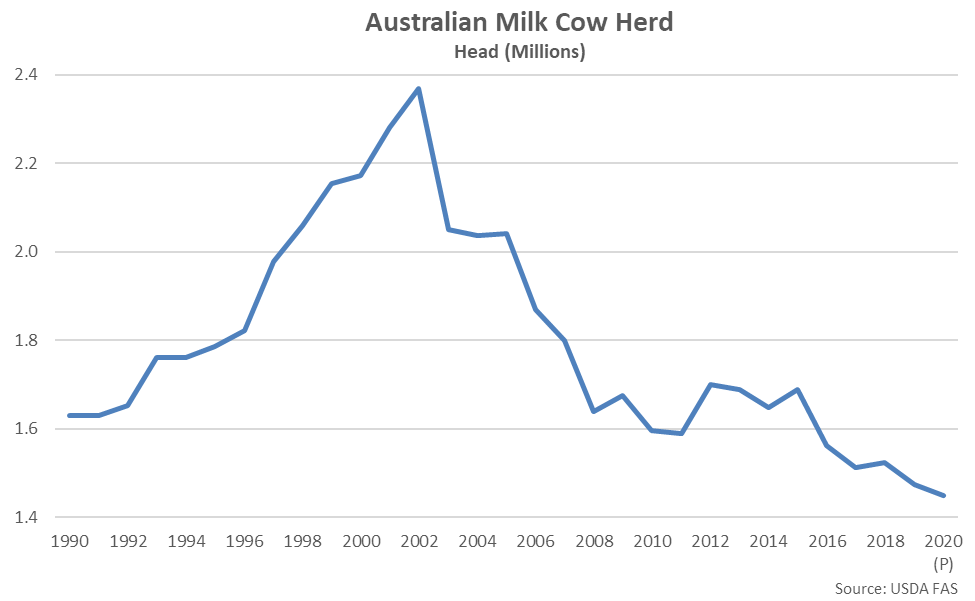 Australia is the fourth largest global dairy exporter, trailing only New Zealand, the EU-28 and the U.S. Of the top five dairy exporting regions accounting for over 90% of total global dairy exports, Australia accounts for 3.0% of total combined milk production and 5.2% of combined butter, cheese, nonfat dry milk (NFDM) and whole milk powder (WMP) export volumes throughout 2019.
Australia is the fourth largest global dairy exporter, trailing only New Zealand, the EU-28 and the U.S. Of the top five dairy exporting regions accounting for over 90% of total global dairy exports, Australia accounts for 3.0% of total combined milk production and 5.2% of combined butter, cheese, nonfat dry milk (NFDM) and whole milk powder (WMP) export volumes throughout 2019.
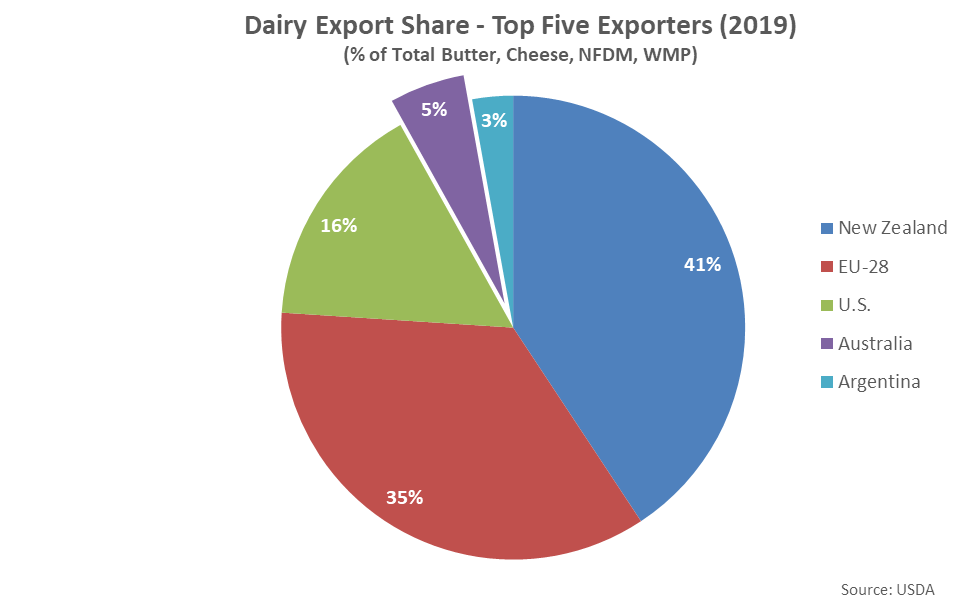 The bulk of Australian dairy exports are in the form of cheese and NFDM. Australia was the fourth largest exporter of both cheese and NFDM throughout 2019, accounting for 7.9% of global cheese export volumes and 5.3% of global NFDM export volumes. From a global perspective, cheese and NFDM markets may be most affected by a continued decline in Australian milk production.
The bulk of Australian dairy exports are in the form of cheese and NFDM. Australia was the fourth largest exporter of both cheese and NFDM throughout 2019, accounting for 7.9% of global cheese export volumes and 5.3% of global NFDM export volumes. From a global perspective, cheese and NFDM markets may be most affected by a continued decline in Australian milk production.
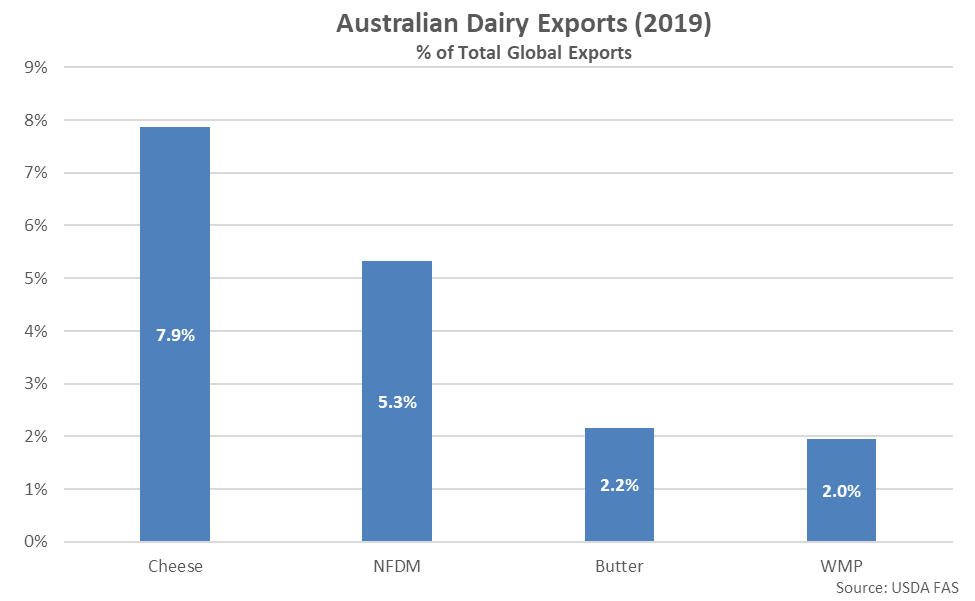
- Australian milk production declined on a YOY basis throughout 18 consecutive months prior to finishing flat with the previous year volumes during Dec ’19. Declines in production are expected to continue into 2020.
- Recently experienced low pasture volumes and supplementary feed on hand contributed to the Australian dairy cow herd contracting by 3.3% throughout 2019, finishing at the lowest figure on record. USDA expects the Australian dairy cow herd will decline by an additional 1.7% throughout 2020.
- Australia is the fourth largest global dairy exporter, accounting for 5.2% of combined butter, cheese, nonfat dry milk and whole milk powder exports throughout 2019. The bulk of Australian dairy exports are in the form of cheese and nonfat dry milk. From a global perspective, cheese and nonfat dry milk markets may be most affected by a continued decline in Australian milk production.
 ’17-’18 annual Australian milk production increased 3.0% from the 20 year low experienced throughout the previous production season as improved rainfall led to better pasture growth however ’18-’19 annual production declined 5.7% as dry weather conditions returned, reaching a 24 year low level, overall. USDA is projecting an additional 2.3% YOY decline in Australian milk production throughout the 2020 calendar year.
’17-’18 annual Australian milk production increased 3.0% from the 20 year low experienced throughout the previous production season as improved rainfall led to better pasture growth however ’18-’19 annual production declined 5.7% as dry weather conditions returned, reaching a 24 year low level, overall. USDA is projecting an additional 2.3% YOY decline in Australian milk production throughout the 2020 calendar year.
 Recently experienced low pasture volumes and supplementary feed on hand contributed to the Australian dairy cow herd contracting by 3.3% throughout 2019, finishing at the lowest figure on record. USDA expects the Australian dairy cow herd will decline by an additional 1.7% throughout 2020, despite projected improvements in pasture conditions, due to biological lags in herd rebuilding.
Recently experienced low pasture volumes and supplementary feed on hand contributed to the Australian dairy cow herd contracting by 3.3% throughout 2019, finishing at the lowest figure on record. USDA expects the Australian dairy cow herd will decline by an additional 1.7% throughout 2020, despite projected improvements in pasture conditions, due to biological lags in herd rebuilding.
 Australia is the fourth largest global dairy exporter, trailing only New Zealand, the EU-28 and the U.S. Of the top five dairy exporting regions accounting for over 90% of total global dairy exports, Australia accounts for 3.0% of total combined milk production and 5.2% of combined butter, cheese, nonfat dry milk (NFDM) and whole milk powder (WMP) export volumes throughout 2019.
Australia is the fourth largest global dairy exporter, trailing only New Zealand, the EU-28 and the U.S. Of the top five dairy exporting regions accounting for over 90% of total global dairy exports, Australia accounts for 3.0% of total combined milk production and 5.2% of combined butter, cheese, nonfat dry milk (NFDM) and whole milk powder (WMP) export volumes throughout 2019.
 The bulk of Australian dairy exports are in the form of cheese and NFDM. Australia was the fourth largest exporter of both cheese and NFDM throughout 2019, accounting for 7.9% of global cheese export volumes and 5.3% of global NFDM export volumes. From a global perspective, cheese and NFDM markets may be most affected by a continued decline in Australian milk production.
The bulk of Australian dairy exports are in the form of cheese and NFDM. Australia was the fourth largest exporter of both cheese and NFDM throughout 2019, accounting for 7.9% of global cheese export volumes and 5.3% of global NFDM export volumes. From a global perspective, cheese and NFDM markets may be most affected by a continued decline in Australian milk production.
